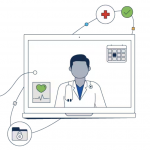Follow along with our blog series #HealthcareNow and #PublicSectorNow, where we’ll address healthcare innovation around the world and how to maintain business continuity in today’s health climate.
What would your life be like without wireless technology?
The average household has over 9 Wi-Fi devices and that number is growing rapidly. Smart speakers. Smart lights. Security cameras. Temperature controls. Virtual assistants. The phenomenal growth of wireless networks is driven by the design evolution of powerful personal devices.
Wireless technology also plays a pivotal role in the orchestration of effective and accessible healthcare. The average hospital room has 25 wireless-enabled devices. That means a small 200-bed hospital contains 5,000 devices or more, not including the many environmental sensors that are deployed to monitor and control other aspects of the hospital environment.
Wireless technologies are now a mission-critical capability in the array of hospital network tools. But, making wireless technologies patient-safe remains a challenge.
Applications are competing for bandwidth and share the radio frequency (RF) spectrum, which compounds issues such as interference, edge of network boundaries, footprints and coverage effectiveness, communication transition points, software interoperability and interfaces, legacy equipment, cybersecurity, and the impact of regulatory changes. These considerations, together with increasing use of bring-your-own-device (BYOD), Internet of Things (IoT) and wireless medical device technologies create a complex environment of operation.
Ensuring reliability in the information flow in wireless systems requires enhanced levels of systems design, deployment and maintenance. There can be no risky workarounds or shadow IT developments. Unlike wired networks, the adaptive nature of wireless, and the flexibility it provides for ad hoc and new connections demands the adoption of a risk-based approach.
Cisco and Flinders University collaborated to develop an evidence-based, comprehensive, and up-to-date method for the design and deployment of complex wireless systems in a healthcare system. The result is a practical guide that enables designers and implementers to employ informed, best and relevant industry practice. It also provides hospital executives governance over the process and the assurance of a safe wireless network, ultimately reducing patient safety issues.
Get the Healthcare Safe Wi-Fi Framework here.
We’d love to hear what you think. Comment below and stay tuned for the next blog in our #HealthcareNow series.



Great post Trish and an interesting white paper.
Its not just the physical challenges of overlapping boundaries and RF interference created by such a high density of wireless and Bluetooth healthcare IT and IoT systems in hospitals but also the security of simple medical devices that were never designed with 2021 in mind or the types of cyber attacks that can easily be executed against them. This is really where a well designed and technically capable wireless network infrastructure comes into its own. By making effective use of Cisco ISE and TrustSec you can micro-segment the entire hospital such that unprotected end points like medical devices can be isolated in a zero trust security model, thus protecting the network from attack from IoT devices, and keeping patients who may be connected to a device, safe from the impacts of a larger hospital network cyber attack.
Now that there are AI based automated tools to build ISE profiles and Security Group Tags (SGTs) this security model just became a whole lot easier to implement.
Interesting post. Good read. Thanks for sharing.